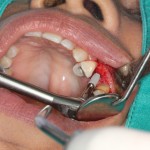
Dental implants are usually placed after raising a flap to visualise the bone where they are to be placed. Several flap designs have been proposed but in some instances, they can also be placed flapless reducing patient discomfort.
The aim of this Cochrane review was to evaluate whether:-
- flapless procedures are beneficial for patients, andwhich is the ideal flap design;
- whether soft tissue correction/augmentation techniques are beneficial for patients, and which are the best techniques;
- whether techniques to increase the peri-implant keratinised mucosa are beneficial for patients, and which are the best techniques; and
- which are the best suturing techniques/materials.
The usual detailed Cochrane review methodology was applied.
Only six trials (138 patients) could be included. One study was at low risk of bias, two studies were judged to be at unclear risk of bias and three at high risk of bias.
Two trials (56 patients) compared flapless placement of dental implants with conventional flap elevation, one trial (10 patients) compared crestal versus vestibular incisions, one trial (20 patients) Erbium:YAG laser versus flap elevation at the second-stage surgery for implant exposure, one split-mouth trial (10 patients) evaluated whether connective tissue graft at implant placement could be effective in augmenting peri-implant tissues, and one trial (40 patients) compared autograft with an animal-derived collagen matrix to increase the height of the keratinised mucosa.
On a patient, rather than per implant basis, implants placed with a flapless technique and implant exposures performed with laser induced statistically significantly less postoperative pain than flap elevation. Sites augmented with soft tissues connective grafts showed a better aesthetic and thicker tissues. Both palatal autografts or the use of a porcine-derived collagen matrix are effective in increasing the height of keratinised mucosa at the price of a 0.5 mm recession of peri-implant soft tissues. There were no other statistically significant differences for any of the remaining analyses.
The authors concluded
There is limited weak evidence suggesting that flapless implant placement is feasible and has been shown to reduce patient postoperative discomfort in adequately selected patients, that augmentation at implant sites with soft tissue grafts is effective in increasing soft tissue thickness improving aesthetics and that one technique to increase the height of keratinised mucosa using autografts or an animal-derived collagen matrix was able to achieve its goal but at the price of a worsened aesthetic outcome (0.5 mm of recession). There is insufficient reliable evidence to provide recommendations on which is the ideal flap design, the best soft tissue augmentation technique, whether techniques to increase the width of keratinised/attached mucosa are beneficial to patients or not, and which are the best incision/suture techniques/materials. Properly designed and conducted RCTs, with at least 6months of follow-up, are needed to provide reliable answers to these questions.
Esposito M, Maghaireh H, Grusovin MG, Ziounas I, Worthington HV. Interventions for replacing missing teeth: management of soft tissues for dental implants. Cochrane Database of Systematic Reviews 2012, Issue 2. Art. No.: CD006697. DOI:10.1002/14651858.CD006697.pub2.
